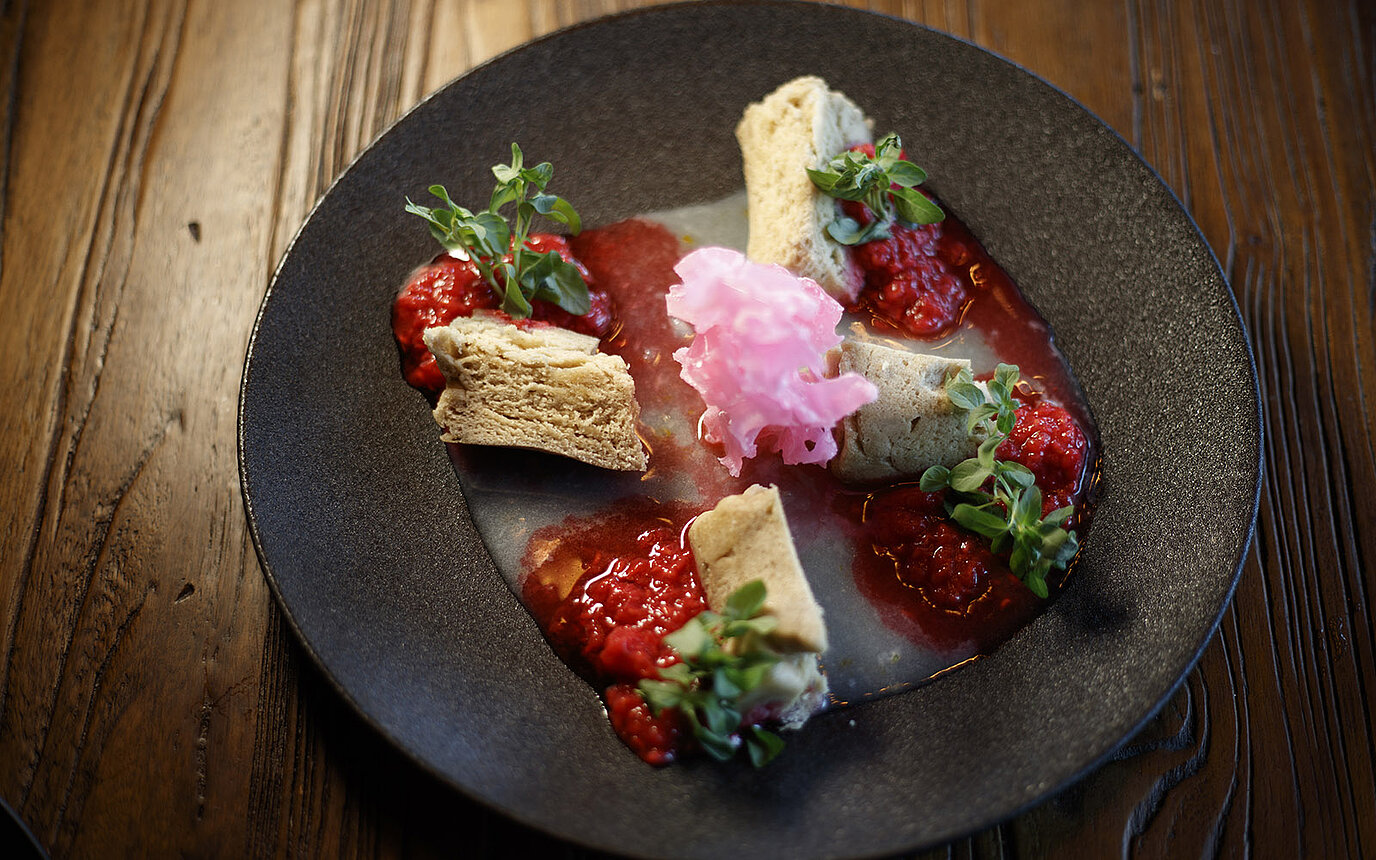As more and more restaurants expand their menus to pre-pandemic abilities, chefs are facing a more demanding consumer who expects more from their dining experience than ever, putting pressure on restaurants to amp up the innovation in their offerings.
As part of the Symrise Flavor North America 2021 Top Flavor Trends Report, we explore the trends of consumers looking to have the best of all worlds in their food and beverage choices: healthy, interesting, and authentic. Chefs are seeing the increasing demand for innovation, and one especially is rising to the challenge.
Chef Jeffrey Schlissel has 30 years of experience in the food world. After serving as an executive chef in kitchens across Palm Beach, Florida, he worked as a “Food Fanatic Chef” with U.S. Foods to develop recipes and consult restaurants on how to innovate with their menu items. He opened his restaurant Locale Gastropub in August of 2020. His recipes include innovative takes on South Floridian and Bahaman food, as well as other upscale and experimental comfort foods that tick the Initiative boxes in the Healthy Lifestyles, Premium Indulgence, Emotional Discoveries, and beyond.
“We wanted to do and develop a menu that was unique, but was also comfortable, people would know what they are,” said Schlissel. “We owe it to our guests because of the pandemic to bring healthier foods and options but also making them full of flavor.”
Healthy Lifestyles
As the COVID-19 pandemic continues to change the world, it has especially brought health and immunity into the spotlight. Consumers are increasingly looking to improve their health through the foods and beverages they choose, seeking out ingredients that are health-promoting. Restaurants are responding by developing recipes with healthy ingredients that don’t skimp on taste.
“People are also looking at being healthier,” said Schlissel. “They're looking at foods and beverages that are immune boosting, but they're also looking for menu items that are fun and full of flavor.”
This is especially true with younger consumers who find many functional ingredients healthier than older consumers, as they may be more informed about the ingredient benefits than their older counterparts. This generation of health-conscious eaters are also bringing about the plant-based movement sweeping across food and beverage categories. Mainstream consumers are looking to incorporate more vegetarian proteins with a specific emphasis on simple, non-processed ingredients. As a result, there is a surging interest in legumes, which are naturally low in fat and high in protein and fiber.
“What I see the difference with legumes, [compared to other plant-based meat] is that it’s an all-natural product and it lends itself to push our boundaries and outside the normal,” said Schlissel.
While chickpeas may be the most well-known and mainstream legume used as a substitute, others like mung beans and lupini beans are emerging as a new meat substitute because of their abundant amino acid profile, protein, and versatility. Aquafaba is becoming a key asset in vegan cooking. It can be whipped, frothed or mixed into any dessert, drink, or meals.
Other meat substitutes are emerging as the move towards healthy eating continues with plant-based alternatives popping up to replace for even the meatiest of ingredients, such as Schlissel’s vegan bone marrow tacos.
“I was slicing hearts of palms and when it split in half it looked like a canoe ... I thought what if I utilize these unusable parts of the plant that are still edible? What if I make a purée of vegetables and utilize that as the ‘guts’ of the bone marrow, and the whole thing gets charred? It looks like bone marrow, but it doesn’t taste like bone marrow, yet still gives that satisfying taste to the palate.”
Schlissel’s menu at Locale Gastropub is packed with inventive and flavorful plant-based options, including a charcuterie board with seitan prosciutto and the Bonjour vegan burger made with house-made seitan; button, oyster, shiitake and cremini mushrooms; pistachio pate; jalapenos; and pickled carrots, providing alternatives to dishes previously unavailable to those on a plant-based diet.
RELATED: Chef Misti Norris Breaks Culinary Boundaries Through Foraging, Fermentation and Fire
Premium Indulgence
When it comes to indulgence, consumers are looking for three things: authenticity, nostalgia, and a premium experience. The experience of trying something new is a significant consumption driver of unique flavors. This includes desires to experience something different, discover new global flavors, have a memorable meal, and share something with others. Diners are more and more interested in getting as close to authentic in their food, especially at a time when they need to use their tastebuds to travel the world from home.
“A lot of times when you’re looking for authentic, we’re not able to get true authentic,” said Schlissel “Yuzu is a great example of that. We can’t get fresh yuzu in the United States, but we sure can get some phenomenal yuzu juice at a premium, too. Yuzu adds such a wonderful flavor profile, like Meyer lemon. We look for things that could be comparable that we can add to give those spice blends that punch we want in a dish.”
Along with trying new flavors, consumers are looking for the comfort of the past but transformed in a more upscale, premium way to satisfy their more grown-palates. Younger consumers especially want more nostalgic items as they may have more recent memories and cravings for these items. Chefs, however, are taking this opportunity to offer more than just a simple cheese pizza or a peanut butter and jelly. Instead, they are experimenting with comforting foods and beverages that are elevated, different, and surprising.
Schlissel concocted an indulgent and nostalgic take on grilled cheese at Locale Gastropub with white balsamic-smoked strawberry jam, chipotle house-infused dark chocolate, and whipped brie on grilled sourdough bread that satisfies both the child inside and the adult seeking comfort in their meal.
Emotional Discoveries
While people are using food as their outlet to discover exotic flavors of the world, they are also looking for the boldest and most extreme versions of some of their favorites, especially in heat and umami flavor profiles. Chefs are beginning to leverage sauces with spice and fermented umami flavors, from harissa to sriracha to gochujang in the Middle East, Mediterranean and Asian regions as well as various islands. The driving demand for these and other fiery, fruity, smoky and sour pepper sauces is leading chefs into new avenues of innovation as consumers ask for, “more heat, please.”
“I love harissa, and sriracha has become a staple,” said Schlissel. “The next thing that I am really jiving to is gochugaru and gochujang; there’s a lot more spices being implied. Here we do our own Scotch bonnet sauce, and we infuse the Scotch bonnet with smoke and add passionfruit. We also add in a touch of guava to give it a sweetness and balance.”
Schlissel’s Locale Gastropub menu also offers smokey innovative condiments, like chipotle guava bourbon barbeque sauce and tangerine habanero marmalade to, “double down on heat and sweet flavors.”
Exotic spices in global cuisines continue to inspire new flavor innovation, particularly in the form of unique spice and seasoning blends. Menus are blends infusing citrus peels, various seeds, peppercorns and herbs being used in stews and soups, salads, egg dishes, roasted vegetables, chicken and seafood. Vadouvan – an Indian spice blend with curry leaves, onion, garlic, cumin seeds, mustard seeds and fenugreek – is on the rise along with other Indian spice mixes as tandoori leads the way in flavor.
“A spice blend that I think is going to become popular personally is Indian,” said Schlissel. “Indian food is the true essence of how United States chefs should position themselves when flavoring their foods ... something where there are so many integral ingredients that give it a full flavor. Tandoori is a great example: a little spice, a little heat, and then it has the vibrant red effervescence that gives a beautiful hue to it.”
Middle Eastern spices and flavors are also increasingly coming into the spotlight. In general, chefs are looking for the boldest earthy, smoky, savory, and hot spice blends to make dishes stand out. Even the most familiar menu staples can be given new depth with the right mix.
“Spiceology has this wonderful malt vinegar powder that is just insane,” said Schlissel. “It gives us a twist that we can use on fish and chips ... and lends us that tartness that we are looking for. It’s a stronger flavor, you have to use it sparingly, but you’re going to get that wonderful acid. The guest is going to be like, ‘Where’s this tartness coming from?’ It’s pushing them to think differently.”
If you're interested in learning more about our 2021 Top Flavor Trends Report, contact us HERE!
Header image courtesy of Locale Gastro Pub.





